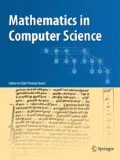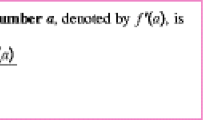Abstract
When teaching function analysis, as part of college calculus, many of the same calculations repeat themselves, over and over again. These calculations are for proving limits (their existance and values, or perhaps the lack thereof), finding minima and maxima, determining continuity and differentiability at specific points, or for ranges, etc. We also present to our students, the summary of the analyses, in the form of detailed, annotated plots. We present the automation of function analysis, for teaching first-semester college calculus. The relevant Mathematica functions (and their options) are demonstrated, in a step-by-step fashion and discussed at length. The application of these functions, to the calculus material, and the pitfalls that can arise, are discussed. In addition to the automated results for limits, extrema, continuity, differentiability, etc., we also show how plotting can be achieved, including all of the analyses learned.
Similar content being viewed by others
References
Wolfram Research, Inc. Mathematica, Version 11.3. Champaign, IL (2018)
Maplesoft. Maple 2018, Waterloo ON, Canada
Hearn, A.C.: Reduce 3.8, Santa Monica, CA, USA (2004). http://www.reduce-algebra.com. Accessed 30 June 2018
Stein, W.A. et al.: Sage Mathematics Software (Version 8.1). The Sage Development Team (2017). http://www.sagemath.org. Accessed 30 June 2018
Brown, A.: Algebra quiz. http://demonstrations.wolfram.com/AlgebraQuiz. Accessed 30 June 2018
Galán-Garca, J.L., Aguilera-Venegas, G., Galán-Garca, M.Á., Rodríguez-Cielos, P., Atencia-Mc.Killop, I.: Improving CAS capabilities: new rules for computing improper integrals. Appl. Math. Comput. 316, 525–540 (2018)
Aguilera-Venegas, G., Galán-García, J.L., Galán-García, M.Á., Rodríguez-Cielos, P.: Teaching semantic tableaux method for propositional classical logic with a CAS. Int. J. Technol. Math. Educ. 22(2), 85–91 (2015)
Samkova, L.: Calculus of one and more variables with Maple. Int. J. Math. Educ. Sci. Technol. 43(2), 230–244 (2012)
Sevimli, E.: Do calculus students demand technology integration into learning environment? Case of instructional differences. Int. J. Educ. Technol. Higher Educ. 13(37) (2016). https://doi.org/10.1186/s41239-016-0038-6
Weigand, H.-G.: What is or what might be the benefit of using computer algebra systems in the learning and teaching of calculus? In: Innovation and Technology Enhancing Mathematics Education, Springer, pp. 161–193 (2017)
Garner, S., Pierce, R.: A cas project ten years on. Math. Teach. 109(8), 584–590 (2016)
Computer-Based Maths. http://computerbasedmath.org. Accessed 30 June 2018
Acknowledgements
The author wishes to thank Dr. Avi Naiman for many interesting correspondences, and helpful comments on the paper.
Author information
Authors and Affiliations
Corresponding author
Electronic supplementary material
Below is the link to the electronic supplementary material.
Rights and permissions
About this article
Cite this article
Naiman, A.E. Automated Function Analysis for Calculus. Math.Comput.Sci. 13, 195–204 (2019). https://doi.org/10.1007/s11786-018-0358-0
Received:
Revised:
Accepted:
Published:
Issue Date:
DOI: https://doi.org/10.1007/s11786-018-0358-0




